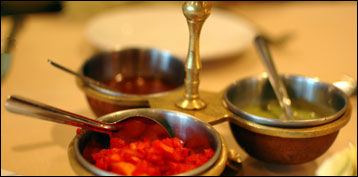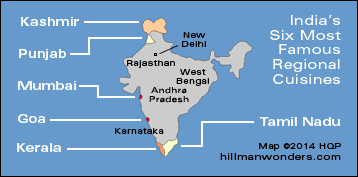



Indian Food
north vs south
page 2

More Northern
and Southern
dissimilarities
 Spices
Spices
They are extremely important in both North and South Indian cuisines - they play a major role in making Indian dishes enticingly aromatic, an Indian cuisine trademark. Still, differences exist. South Indians prefer to cook with freshly prepared spice and herb mixtures while northerners tend to use powdered seasoning blends. Chilies are used in greater quantity in the south. Tamarind or other souring agents are common seasonings while onions and garlic are not - the pposite is true in North India.
 Vegetarianism
Vegetarianism
It is more prevalent in the south, which partially explains why you'll usually find better-conditioned fruits and vegetables in Southern marketplaces. It's more essential for non-meat than meat eaters to gain maximum nutrition from perfectly fresh produce, so there's more of a marketplace demand for it.
 Cooking fat
Cooking fat
The principal cooking medium in South India is vegetable oil derived from sunflower and other seeds - the prime exception occurs in coastal Kerala where coconut oil reigns. Ghee, a clarified butter, is the traditional cooking fat in North India, though vegetable oil has recently gained considerably in popularity.
 Heritage
Heritage
The Indian cuisine of the south is truer to its ancestral roots - most of what you taste today is very much like what Southerners ate 500 years ago. Not so in the North, which assimilated many foreign influences, particularly the cooking style of the Mogul Empire, which was founded in India by conquerors from the Middle East.
Learn More
 for first India North vs South page
for first India North vs South page
Learn my Indian Cuisine tips
and insights on these pages
Click blue links

India's 6 most famous
regional cuisines
Mumbai
Kashmir
Goa
Kerala
Punjab
Tamil Nadu
Runners-up
Related pages
North vs South Indian cuisines
Indian food - Home Page
Top 10 Travel Wonders of India
Photo by Kickthebeat - CC BY 2.0


Rankings
Peasant recipes
World wonders
Also read
Site map
About me and my credentials
About my website
Reader testimonials
Email me your opinion



